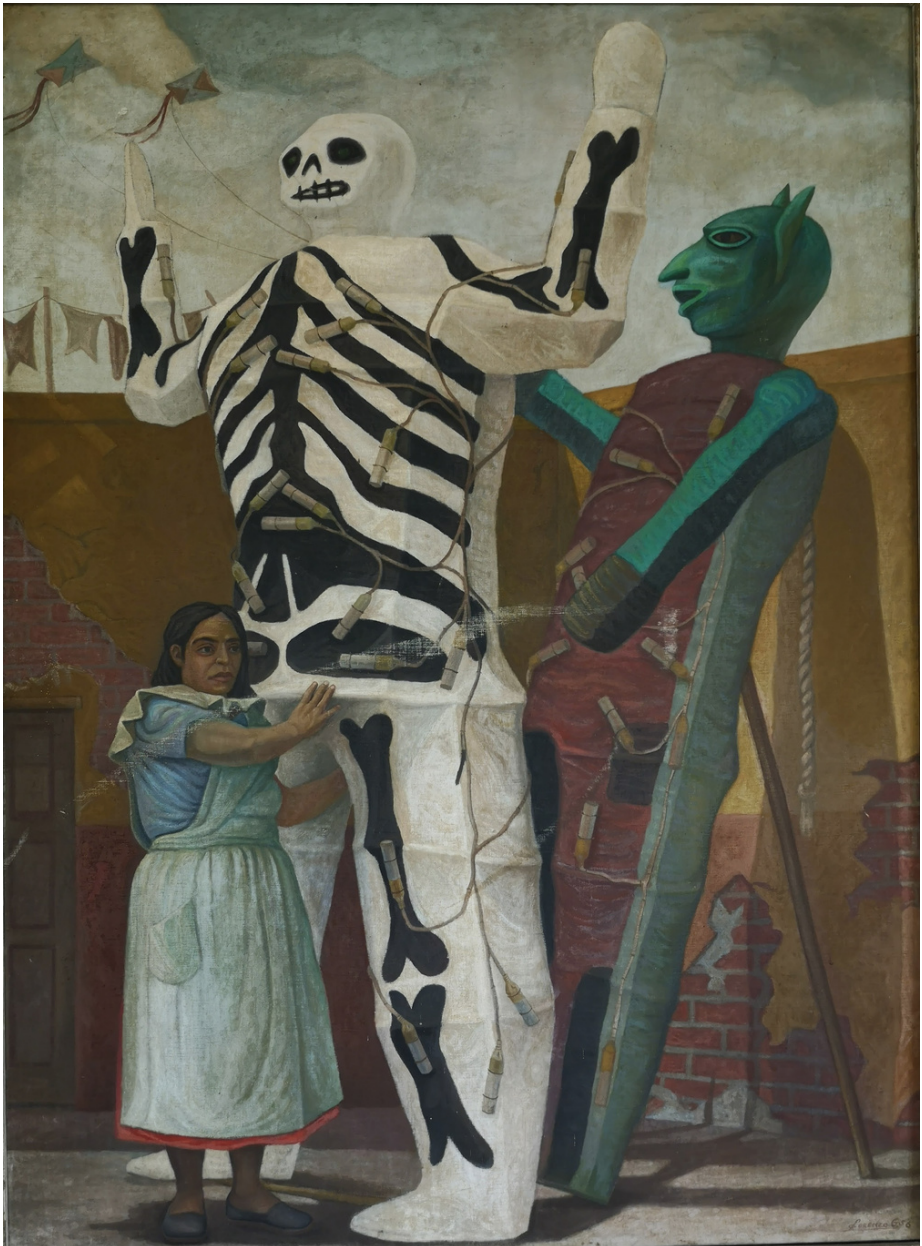RENI ALVAREZ COLLECTION
RENI ALVAREZ COLLECTION
LORENZO GUERRERO

"LOS JUDAS"
OIL ON WOOD
1,25 X 93CM
NOT FOR SALE
Lorenzo Guerrero was part of one of the most prolific generations of artists in the history of Mexican art. Engraver and painter of popular subjects that shows the traditions of Mexico in his art. In the 50s with the eyes of the world on artists such as Diego Rivera, Frida Kahlo, Orozco, Siqueiros, an important impulse to art and its expressions, happened, which at that time reflected themes such as the revolution, pre hispanic communities, and traditions of Mexico. Lorenzo Guerrero was part of the «Frente Nacional de las Artes Plasticas» (National Front of Plastic Arts). It was a collective of collectives founded in 1952, just at a time of «crossing» between two adverse aesthetic trends: the realism of the so-called Escuela Mexicana de Pintura» (Mexican School of Painting) and what has been called «Ruptura» (breaking off). The organization proposed the construction of a large-scale cultural project, which included improving the economic conditions of creators, especially of young people who lacked dissemination and support in a country where there was not enough market for artistic work and the greater patron was the state. Who organized this collective? Painters, teachers of artistic education as normalist teachers, some of whom were active in the Mexican Communist Party (PCM) or other leftist groups. Still others did not show any political tendency. According to its organizers, it was a kind of broad front, in which the left and the progressive bourgeoisie could unite. However, the same call reiterated the defense of the «plastic tradition», understood as the iconography whose themes were the people, the worker, the landscape, the Mexican flora and fauna, heroes and social issues.
With this front, it is proposed to open different art schools throughout the country, as well as the impulse of the government through «Instituto Nacional de Bellas Artes» (National Institute of Fine Arts), to promote art outside of Mexico (as was the Organization for the International Promotion of Culture OPIC), organising international biennials where Lorenzo Guerrero was selected to participate with his work «Los Judas», in the exhibition «Contemporary Painting of Mexico» at the National Museum of Colombia in Bogotá in 1961.
In this period, the prints and subjects drew the attention of the Blastein Collection, a museum in California that acquired an engraving of the portrait of Emiliano Zapata and other collectors such as Miguel Alvarez Acosta, who was director of «Bellas Artes» to be added in their collections. As a result of the Frente Nacional de las Artes Plasticas, improvements are achieved in art schools, and support for the artists who studied in them. One of the schools that changed the art scene in Mexico was «La Esmeralda» (National School of Painting, Sculpture and Engraving) located in México city. The best artists of that time taught in this school, such as Guillermo Ruíz, Francisco Zuñiga, Maria Izquierdo, Luis Ortiz Monasterio, Diego Rivera, and Frida Kahlo among many others. In the period from 1985 to 1991 Lorenzo Guerrero was proclaimed director of the National School of Painting, Sculpture and Engraving, ENPEG, better called «La Esmeralda».
Los Judas were part of the exhibition Frente Nacional de Artes Plasticas «Por un arte al servicio del pueblo». (the National Front of Plastic Arts exhibition «For an art at the service of the people.») in 2017 at Diego Rivera and Frida Kahlo´s House Museum. In addition to characters such as Diego Rivera, David Alfaro Siqueiros, María Izquierdo, Pablo O´ Higgins and Francisco Zúñiga, the exhibition promoted the work of other characters that perhaps are not as famous as the previous ones, such as Rosendo Soto, Gilberto Aceves Navarro, Fanny Rabel , Elena Huerta, Luis Arenal, Elizabeth Catlett, Lorenzo Guerrero, Susana Neve and Isidro Ocampo. The exhibition For an art at the service of the people was made up of 80 works, which ranged from painting and sculpture to engravings and photography, for the work and commitment to promote Mexican plastic art, both in Mexico and abroad. It is worth mentioning that the exhibition has a lot of unpublished material, essential to understand Mexican culture through the eyes of the artists who to date continue to permeate our identity. There is not much work of Lorenzo Guerrero in the market, but there is no boubt that he played an important role in Mexican Art History, and was part of a generation that changed, promoted and spreaded Mexican traditions through art.
The burning of Judas in Mexico is one of the traditions of the Catholic religion in which the triumph of good over evil is celebrated, hence the figure to be burned is that of a devil. This cardboard figure makes reference to Judas Iscariot, the man betrayed and gave Jesus in exchange for a silver coin, but when he did not bear the charge of conscience he ended up hanging himself in a tree. It is because of this story that I name this figure who is burned at Easter. This deeply ingrained tradition in Mexico has its origin with the arrival of the Spanish conquerors, who used the figure of Judas to evangelize the indigenous people and represent the story of Judas Iscariot and his betrayal of Jesus. The judas They are made by townspeople for the people, without grafting or sophistication and go much further in the way that school and gallery painters attempt. It was these types of pieces that Rivera came to find on one of his walks through the Abelardo L. Rodríguez Market. The muralist did not take long to appreciate the peculiarity of the cardboard Judas, about which he even mentioned: “… as a plastic object, a joint expression of structure and color, in contemporary Mexican art, they are undoubtedly the most valuable.
ABOUT THE WORK
The National Front of Plastic Arts managed to capture the everyday Mexico, full of traditions, figures and symbols. The artists of the Frente generated a lot of work of art portraying moments, trades, social conflicts, and pre-Hispanic Mexico.
The burning of Judas in Mexico is one of the traditions of the Catholic religion in which the triumph of good over evil is celebrated, hence the figure to be burned is that of a devil. This cardboard figure makes reference to Judas Iscariot, the man betrayed and gave Jesus in exchange for a silver coin, but when he did not bear the charge of conscience he ended up hanging himself in a tree. It is because of this story that I name this figure who is burned at Easter. This deeply ingrained tradition in Mexico has its origin with the arrival of the Spanish conquerors, who used the figure of Judas to evangelize the indigenous people and represent the story of Judas Iscariot and his betrayal of Jesus. The judas They are made by townspeople for the people, without grafting or sophistication and go much further in the way that school and gallery painters attempt. It was these types of pieces that Rivera came to find on one of his walks through the Abelardo L. Rodríguez Market. The muralist did not take long to appreciate the peculiarity of the cardboard Judas, about which he even mentioned: “… as a plastic object, a joint expression of structure and color, in contemporary Mexican art, they are undoubtedly the most valuable.
We can see two giant judas leaning on a typical wall of the large houses of Mexico City and detained by «La Judera» who was the woman who built these figures and were well respected as great artists. It is an image that speaks a lot about the Mexico of the 40s and 50s of its symbols, its colors, syncretisms and the national traditions. Undoubtedly a unique piece for its aesthetic, historical and cultural value.
Address
MEXICO CITY
CONTACT US
info@renialvarezcollection.com
